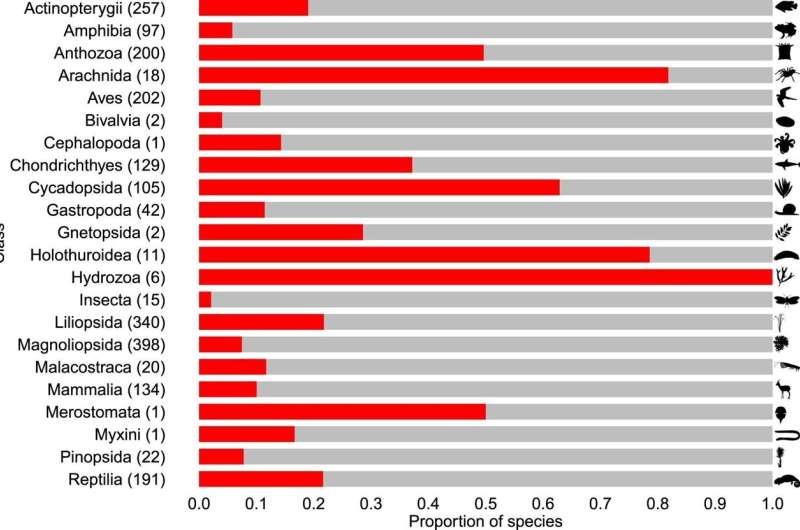This article has been reviewed according to Science X's editorial process and policies. Editors have highlighted the following attributes while ensuring the content's credibility:
fact-checked
peer-reviewed publication
proofread
More than 900 at-risk animal and plant species not covered by global trade protections, new research shows

With the overexploitation of animals and plants being a major threat to nature, and new international pledges to halt species extinctions and ensure the harvest, use and trade in wild species is sustainable as part of the UN-brokered deal for nature—the Kunming-Montreal Global Biodiversity Framework—now in place, the researchers set out to identify potential gaps in international trade protections for the world's biodiversity.
The study was conducted by a team of ecologists and wildlife trade experts at the University of Oxford, the International Union for Conservation of Nature (IUCN), the UN Environment Program World Conservation Monitoring Center (UNEP-WCMC) and ZSL. The research was published in Nature Ecology and Evolution, and it cross-references wildlife trade information with data on species under threat.
International wildlife trade protections are set by the Convention on International Trade in Endangered Species of Wild Fauna and Flora (CITES), as part of which signatory countries—termed "Parties to the Convention"—periodically decide on trade controls for thousands of animal and plant species. About 40,000 species are currently included in the CITES Appendices. However, in the absence of a robust, repeatable methodology to inform the listing process, there is the potential that species threatened by international trade could be missing out on much-needed global protections.
The researchers used the IUCN's Red List of Threatened Species—the most authoritative global source on at-risk animals and plants—to identify species likely threatened by international trade, and compared these findings with CITES-listed species to identify potential gaps and develop a repeatable methodology.
Of the 904 species found to be likely threatened by international trade but without corresponding protection, hundreds are fish and flowering plants, with many species of birds, reptiles and amphibians also identified.
The list of 370 Endangered or Critically Endangered animals and plants in need of protection from overexploitation from international trade include 31 species of shark and ray traded for their meat and fins, as well as 23 species of palm heavily traded for horticulture. The list of species also includes the Endangered Owston's Civet—which is snared for wild meat and traditional medicine—and the Endangered Greater Green Leafbird—which is caught for the songbird trade.
The potential for gaps in species protections has been raised during recent CITES meetings, and the researchers are now calling for their findings and methodology to be used to inform Parties about species that may merit consideration for potential listing proposals at future CITES Conference of the Parties (CoPs).
Dr. Dan Challender, Research Fellow at the University of Oxford and lead author of the study, said, "CITES listings should respond to the best available information on a species' status and be adopted where they will be likely to benefit the species. While our research shows CITES performs moderately well at identifying species in need of trade regulation, it also suggests that hundreds of species are overlooked.
"Cross-referencing data from the Red List with CITES listing information brings these potential protection gaps to light, and I hope that Parties to the Convention will use our methodology to inform their decisions in the run-up to and during the next CITES CoP, currently scheduled to take place in 2025."
The researchers' methodology has been developed so it can be updated along with ongoing revisions to the IUCN Red List, and the team highlight a range of steps that the CITES committees can take to incorporate the findings.
The team's analysis also identified 1,307 species that are CITES-listed and likely threatened by international trade, despite this trade being regulated under the Convention. This indicates that these species may require increased scrutiny to determine whether there are sustainability issues that may merit tighter controls through CITES provisions, as well as other measures.
Importantly, the results are also not limited to identifying species in need of greater trade regulation. Equally, they can inform the relaxation of trade controls for species that have improved in status and can potentially be traded sustainably.
Kelly Malsch, UNEP-WCMC's Head of Nature Conserved and study co-author, said, "To achieve the aims of both CITES and the new Global Biodiversity Framework on tackling nature loss, it is vital that the international trade in animal and plant species is both sustainable and does not threaten the survival of the species in the wild.
"Our work identifies hundreds of species—including 370 Critically Endangered and Endangered species—in need of protections, and we also know data gaps mean the true figure could be much higher. We hope that CITES Parties will be able to use our new methodology in future to ensure that CITES listings are based on the best available science."
More information: Daniel W. S. Challender et al, Identifying species likely threatened by international trade on the IUCN Red List can inform CITES trade measures, Nature Ecology & Evolution (2023). DOI: 10.1038/s41559-023-02115-8
Journal information: Nature Ecology & Evolution
Provided by UNEP-WCMC


















